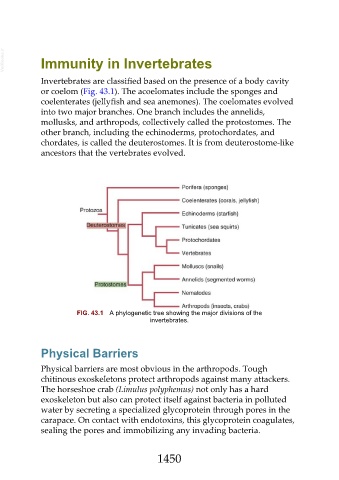Page 1450 - Veterinary Immunology, 10th Edition
P. 1450
VetBooks.ir Immunity in Invertebrates
Invertebrates are classified based on the presence of a body cavity
or coelom (Fig. 43.1). The acoelomates include the sponges and
coelenterates (jellyfish and sea anemones). The coelomates evolved
into two major branches. One branch includes the annelids,
mollusks, and arthropods, collectively called the protostomes. The
other branch, including the echinoderms, protochordates, and
chordates, is called the deuterostomes. It is from deuterostome-like
ancestors that the vertebrates evolved.
FIG. 43.1 A phylogenetic tree showing the major divisions of the
invertebrates.
Physical Barriers
Physical barriers are most obvious in the arthropods. Tough
chitinous exoskeletons protect arthropods against many attackers.
The horseshoe crab (Limulus polyphemus) not only has a hard
exoskeleton but also can protect itself against bacteria in polluted
water by secreting a specialized glycoprotein through pores in the
carapace. On contact with endotoxins, this glycoprotein coagulates,
sealing the pores and immobilizing any invading bacteria.
1450

